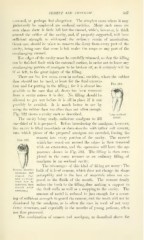Page 349 - My FlipBook
P. 349
CEME]^T AND AMALGAM. 347
crowned, or perhaps lost altogether. The simplest cases where it may
judiciously be employed are occlusal cavities. Many such cases are
seen where there is little left but the enamel, which, however, is thick
around the orifice of the cavity, and, if properly supported, will have
sufficient strength to withstand the ordinary strain of mastication.
Great care should be taken to remove the decay from every part of the
cavity, being sure that none is left under the cusps or any part of the
overhanging enamel.
The edges of the cavity must be carefully trimmed, so that the filling
can be finished flush with the external surface, in order not to leave any
overhanging portion of amalgam to be broken off, as it certainly will be
if so left, to the great injury of the filling.
There are but few cases, even in occlusal cavities, where the rubber
dam should not be used, at least for the final excava-
Fig. 322.
tion and for putting in the filling ; for it is almost im-
possible to be sure that all decay has been removed
from a cavity unless it is dry. No filling should be
allowed to get wet before it is all in place if it can
possibly be avoided. It is much better to err by
using the rubber dam too often than not often enough.
Fig. 322 shows a cavity such as described. Large occlusal
cavity.
The cavity being ready, sufficient amalgam to fill
one-third of it is prepared. Before introducing the amalgam, however^
the cavity is filled two-thirds or three-fourths with rather soft cement,
into which pieces of the prepared amalgam are crowded, forcing the
cement into every portion of the cavity. The cement
which has oozed out around the edo-es is then removed
Avith an excavator, and the operation will have the ap-
pearance shown in Fig. 323. The filling is then com-
pleted in the same manner as an ordinary filling of
amalgam in an occlusal cavity.
The advantages of this kind of filling are many The
:
Section showing
bulk of it is of cement, which does not change its shape
amalgam and
perceptibly and is the best of materials when not ex-
cement. (Sur-
plus cement posed to the fluids of the mouth. The cement firmly
must now be
removed; then unites the tooth to the filling, thus making a support to
the frail walls as well as a stopping to the cavity. The
amait'amT^
amount of metal is reduced to just enough for a cover-
ing of sufficient strength to guard the cement, and the tooth will not be
discolored by the amalgam, as is often the case in teeth of not very
dense structure, and especially in the mouths of young patients, when
not thus protected.
The combination of cement and amalgam, as described above for


